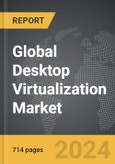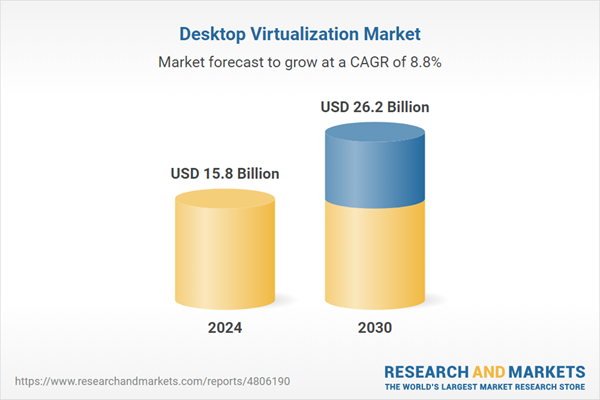The global market for Desktop Virtualization was valued at US$15.8 Billion in 2024 and is projected to reach US$26.2 Billion by 2030, growing at a CAGR of 8.8% from 2024 to 2030. This comprehensive report provides an in-depth analysis of market trends, drivers, and forecasts, helping you make informed business decisions.
In recent years, the desktop virtualization market has witnessed diverse trends shaping its trajectory. There has been a notable shift towards hybrid models that combine on-premises and cloud-based solutions, catering to the varied needs of enterprises. Moreover, advancements in virtualization software and hardware have significantly enhanced the user experience, making virtual desktops more responsive and reliable. The market has also seen increased investments in research and development, leading to innovations such as enhanced graphics support and better integration with other enterprise applications. As a result, companies are now able to deploy more complex and resource-intensive applications on virtual desktops, broadening the scope of desktop virtualization use cases.
The growth in the desktop virtualization market is driven by several factors. Primarily, the rising need for secure remote access to organizational resources has been a major driver, especially in the context of growing cybersecurity threats. Additionally, the increasing trend of Bring Your Own Device (BYOD) policies in workplaces has necessitated solutions that can support diverse device environments without compromising on security or performance. Cost reduction is another critical factor, as desktop virtualization helps organizations cut down on hardware expenses and operational costs associated with managing physical workstations. Furthermore, the push towards digital transformation and the adoption of cloud technologies have made desktop virtualization an integral part of IT strategies for many enterprises. These factors collectively contribute to the robust growth of the desktop virtualization market.
Global Desktop Virtualization Market - Key Trends & Drivers Summarized
Desktop virtualization, a technology that allows users to simulate a workstation environment remotely, has experienced substantial growth. The recent market research report highlights the significant advancements and adoption trends within this sector. Desktop virtualization enables organizations to improve efficiency, manage resources better, and enhance security protocols. As businesses increasingly adopt cloud computing and seek cost-effective IT solutions, the demand for desktop virtualization has surged. The technology's ability to streamline operations, reduce hardware dependency, and support remote work has been a game-changer in various industries. Key players in the market are continuously innovating to offer more robust, secure, and user-friendly virtualization solutions, which further propels market expansion.In recent years, the desktop virtualization market has witnessed diverse trends shaping its trajectory. There has been a notable shift towards hybrid models that combine on-premises and cloud-based solutions, catering to the varied needs of enterprises. Moreover, advancements in virtualization software and hardware have significantly enhanced the user experience, making virtual desktops more responsive and reliable. The market has also seen increased investments in research and development, leading to innovations such as enhanced graphics support and better integration with other enterprise applications. As a result, companies are now able to deploy more complex and resource-intensive applications on virtual desktops, broadening the scope of desktop virtualization use cases.
The growth in the desktop virtualization market is driven by several factors. Primarily, the rising need for secure remote access to organizational resources has been a major driver, especially in the context of growing cybersecurity threats. Additionally, the increasing trend of Bring Your Own Device (BYOD) policies in workplaces has necessitated solutions that can support diverse device environments without compromising on security or performance. Cost reduction is another critical factor, as desktop virtualization helps organizations cut down on hardware expenses and operational costs associated with managing physical workstations. Furthermore, the push towards digital transformation and the adoption of cloud technologies have made desktop virtualization an integral part of IT strategies for many enterprises. These factors collectively contribute to the robust growth of the desktop virtualization market.
Scope of the Study
The report analyzes the Desktop Virtualization market, presented in terms of market value (US$ Thousand). The analysis covers the key segments and geographic regions outlined below.Segments:
Type (Virtual Desktop Infrastructure (VDI), Desktop-as-a-Service (DaaS), Remote Desktop Services (RDS)); Organization Size (Large Enterprises, SMEs); Vertical (IT & Telecom, BFSI, Supply Chain & Warehouse, Education & Entertainment, Other Verticals).Geographic Regions/Countries:
World; USA; Canada; Japan; China; Europe; France; Germany; Italy; UK; Spain; Russia; Rest of Europe; Asia-Pacific; Australia; India; South Korea; Rest of Asia-Pacific; Latin America; Argentina; Brazil; Mexico; Rest of Latin America; Middle East; Iran; Israel; Saudi Arabia; UAE; Rest of Middle East; Africa.Key Insights:
- Market Growth: Understand the significant growth trajectory of the Virtual Desktop Infrastructure (VDI) segment, which is expected to reach US$14.1 Billion by 2030 with a CAGR of a 8.5%. The Desktop-as-a-Service (DaaS) segment is also set to grow at 9.6% CAGR over the analysis period.
- Regional Analysis: Gain insights into the U.S. market, valued at $4.1 Billion in 2024, and China, forecasted to grow at an impressive 10.7% CAGR to reach $3.4 Billion by 2030. Discover growth trends in other key regions, including Japan, Canada, Germany, and the Asia-Pacific.
Report Features:
- Comprehensive Market Data: Independent analysis of annual sales and market forecasts in US$ Million from 2024 to 2030.
- In-Depth Regional Analysis: Detailed insights into key markets, including the U.S., China, Japan, Canada, Europe, Asia-Pacific, Latin America, Middle East, and Africa.
- Company Profiles: Coverage of major players such as Cisco Systems, Inc., Citrix Systems, Inc., Commvault Systems, Inc., DELL Technologies Inc., Ericom Software, Inc. and more.
- Complimentary Updates: Receive free report updates for one year to keep you informed of the latest market developments.
Why You Should Buy This Report:
- Detailed Market Analysis: Access a thorough analysis of the Global Desktop Virtualization Market, covering all major geographic regions and market segments.
- Competitive Insights: Get an overview of the competitive landscape, including the market presence of major players across different geographies.
- Future Trends and Drivers: Understand the key trends and drivers shaping the future of the Global Desktop Virtualization Market.
- Actionable Insights: Benefit from actionable insights that can help you identify new revenue opportunities and make strategic business decisions.
Key Questions Answered:
- How is the Global Desktop Virtualization Market expected to evolve by 2030?
- What are the main drivers and restraints affecting the market?
- Which market segments will grow the most over the forecast period?
- How will market shares for different regions and segments change by 2030?
- Who are the leading players in the market, and what are their prospects?
Some of the 104 major companies featured in this Desktop Virtualization market report include:
- Cisco Systems, Inc.
- Citrix Systems, Inc.
- Commvault Systems, Inc.
- DELL Technologies Inc.
- Ericom Software, Inc.
- Hewlett Packard Enterprise Company
- Hive-IO
- Huawei Technologies Co., Ltd.
- IBM Corporation
- Microsoft Corporation
- NComputing Co. Ltd.
- Oracle Corporation
- Parallels International GmbH
- Red Hat, Inc.
- VMware, Inc.
- Wipro Ltd.
Table of Contents
I. METHODOLOGYMII. EXECUTIVE SUMMARY2. FOCUS ON SELECT PLAYERSIII. MARKET ANALYSISCANADAFRANCEGERMANYITALYUNITED KINGDOMSPAINRUSSIAREST OF EUROPEAUSTRALIAINDIASOUTH KOREAREST OF ASIA-PACIFICLATIN AMERICAARGENTINABRAZILMEXICOREST OF LATIN AMERICAMIDDLE EASTIRANISRAELSAUDI ARABIAUNITED ARAB EMIRATESREST OF MIDDLE EASTAFRICAIV. COMPETITION
1. MARKET OVERVIEW
3. MARKET TRENDS & DRIVERS
4. GLOBAL MARKET PERSPECTIVE
UNITED STATES
JAPAN
CHINA
EUROPE
ASIA-PACIFIC
Companies Mentioned (Partial List)
A selection of companies mentioned in this report includes, but is not limited to:
- Cisco Systems, Inc.
- Citrix Systems, Inc.
- Commvault Systems, Inc.
- DELL Technologies Inc.
- Ericom Software, Inc.
- Hewlett Packard Enterprise Company
- Hive-IO
- Huawei Technologies Co., Ltd.
- IBM Corporation
- Microsoft Corporation
- NComputing Co. Ltd.
- Oracle Corporation
- Parallels International GmbH
- Red Hat, Inc.
- VMware, Inc.
- Wipro Ltd.
Table Information
| Report Attribute | Details |
|---|---|
| No. of Pages | 714 |
| Published | April 2025 |
| Forecast Period | 2024 - 2030 |
| Estimated Market Value ( USD | $ 15.8 Billion |
| Forecasted Market Value ( USD | $ 26.2 Billion |
| Compound Annual Growth Rate | 8.8% |
| Regions Covered | Global |









